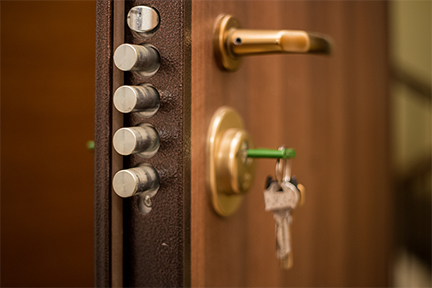Get Easy Wins

This article is in a series based on the Sheepdog Church Security resource, Steps to Start a Safety Ministry, which includes a 28-page Do-It-Yourself Security Assessment.[1] This will help you add layers of safety and security to your church. You may want to have this free download on hand when reading the article. Click Here to get it.
In the Bible
The four chief gatekeepers, who were Levites, were entrusted to be over the chambers and the treasures of the house of God. And they lodged around the house of God, for on them lay the duty of watching, and they had charge of opening it every morning (1 Chronicles 9:26-27).
"You shall know that your tent is at peace, and you shall inspect your fold and miss nothing" (Job 5:24b).
"Is not this a brand plucked from the fire?” (Zechariah 3:2).
In the News
Anna, Illinois, September 28, 2009 - A brutal attack on two elderly women working in a church during the week[2] spurred other churches in Southern Illinois to consider security measures to protect their congregations and staff. The first action for most of these churches was access control (locking doors when church staff and/or the pastor were in the church). It also included consideration of armed security volunteers.[3]
Austin, Texas, March 2020 - The Attorney General of Texas, Ken Paxton, has opened a website to provide information and other resources to volunteer security teams in places of worship. This follows changes in Texas law which first allowed unlicensed volunteers to form security teams (under certain conditions), then permitted concealed weapons to be carried in places of worship. The site provides detailed information as to what Texas law allows and what it requires of volunteer security teams.[4]
Loveland, Colorado, no date - The publishers of Children's Ministry magazine list several ways to promote the safety and well-being of the children in your church. The article begins with a scenario illustrating how access control works in the children's area of a church to prevent kidnapping by a non-custodial parent. The article also provides links to organizations with information and training in children's ministry safety and security - Sheepdog Church Security is one of the linked organizations.[5]
Gering, Nebraska, 2017-2019 - According to an article in Crux sourced from the Associated Press, concerned persons in one of the churches in Gering attempted to start a security team. This followed several thefts from the church, as well as the shootings in Antioch, TN, and Sutherland Springs, TX. On the heels of the shooting incident at West Freeway Christian Church in 2019, churches in Gering and nearby Scottsbluff were seriously considering armed security teams.[6]
Franklin, Tennessee, January 8, 2018 - According to Thom Rainer, security measures, including safety teams and surveillance technology, are becoming the "new normal" for churches. This results from reports of sexual abuse and armed attacks.[7]
Special Resource
Practical Steps to Start a Safety Ministry and a DIY Security Assessment[1] is our special resource for this month. Get it by clicking Here. You can also see Kris's videocast, Steps to Starting a Safety Ministry.[8] By signing up for the download, you subscribe to future articles by email so you will not miss out on future information.
Talking Turkey
"Now we're talking turkey" - our conversation really matters. When we see the need, have shared our concerns with others, and have gathered a group of like-minded individuals, we can make practical moves toward starting a safety/security ministry in our church. In our key resource Practical Steps, Step #2 is "Get an Easy Win," and Step #3 is "Schedule a Meeting with Your Pastor and Other Church Leaders."
Once the Church Safety Ministry is established, all members of the ministry can take the basic Sheepdog Church Security training course, Security Team Fundamentals.[9]
Get an Easy Win
Kris says in Steps to get an "easy win." This means doing something which does not require a lot of planning, training, and coordination, yet has positive results with almost no chance of failure. What works best in your church can be influenced by current events.
We'll present three potential demonstration projects here: Security Patrol, Access Check (Lock Patrol), and Fire Extinguisher Check, then mention a couple of others.
Security Patrol
In the document and the videocast, Kris recommends a security patrol. Select some of the like-minded persons to go around the premises during services with the knowledge and blessing of the church leadership, having their cell phones with them. They will take note of anything out of the ordinary. If it is serious enough, call 911. At least call the coordinator to come take a look.
How does this work? As with the church in Vienna, IL, it meets a known need. Thieves and other intruders seek unauthorized entrance into the church building. Their greatest threat and deterrent is detection. An advantage of this project is that it would be a regular activity using a known team.
Access Check (Lock Patrol)

A variation on this is a "lock patrol" during off-hours or when only pastors and/or staff are in the church. Show up and do an access check on all doors and windows to see if they are locked, watching for any signs of attempted forced entry or preparation for such (such as a hidden item for prying a door or breaking a window). Like the Security Patrol, this is a regularly recurring activity. Schedule a different team member for each day during the week. Over a few weeks, this will use the entire team.
Fire Extinguisher Check
If a recent fire in another publicly-accessed facility in the community has aroused concern for fire safety, arrange a fire extinguisher check. Your like-minded volunteers break into teams of two or three to locate every fire extinguisher in the church. Each extinguisher is checked for date of last inspection, the pressure indicated on the gauge, and whether it has been discharged. These findings are recorded in a log. This project can be done with minimal training. The only actual expense is the log sheets on clipboards. Finding just one or two fire extinguishers that do not pass the check enables correction and shows the worth of a safety team.
The disadvantage of the Fire Extinguisher Check is that it is infrequent, being done only one, two, or three times a year, though eventually it could be monthly. This opening project could be a lead-in to the Security Patrol.
Other possible win-win projects include a health check or a CPR demonstration after the morning service. This may be especially welcome with older members of the congregation. The CPR demonstration (plus the Heimlich Maneuver) may catch the attention of young people. These are infrequent, but could raise interest in a medical response team.
Schedule a Meeting

Request a meeting with the Pastor(s). This may include a few others of the church leadership. The purpose of this meeting is to secure the permission and blessing of the church for the project. Your choice of the first project may depend on the mindset of the congregation. Some Christian communities are very wary of any active security. Some traditionalists may even object to locking doors, though locked church doors are more acceptable now than they were 50 years ago. The idea of the meeting and the introductory activity is to accustom the congregation and its leadership to promoting safety and show them that they can take responsible measures.
This step requires more preparation on your part. Know what to tell in your presentation. Introduce the topic by explaining that you and the team want to begin a security patrol. Focus on the value of the patrols and/or inspections. For now, stick to the proposed initial project (such as the security patrol).
Try the "Think like a criminal" tactic. Case the church. Take notes and photos of things both inside and outside which make your church inviting to criminals. This will be a natural if the church has been burglarized, since the leadership will be more receptive. They know how that thief got in - you've just discovered other vulnerabilities.
If your project is the Fire Extinguisher Check, disclose fire hazards and evacuation barriers you have seen. They may be ready for more than checking extinguishers and ask for a fire hazard cleanup.
Be ready to answer tough questions. The pastor or board member may ask how the team will be organized, who will lead it, and what kind of people will be on the team. Other questions may be about biblically justifying taking security measures, such as, "Can't we just trust God to protect us?" Someone will want to know how much this project will cost or how long it will go on.
If someone wants to know about the risks of crime, have statistics ready. You can find them at Uniform Crime Reporting Statistics[10] and other sources, such as Carl Chinn's Faith Based Security Network website.[11]
Key leaders like to stay in the loop. After the go-ahead to plan the project, get back with the pastor. Keep him or her up-to-date on the project's development.
Conclusion
When proposing a Church Safety Ministry, it pays to work with church leaders and to start with an easily doable task. Success in a needed area helps build support for more involvement of the Safety Ministry. From this start in one area of church safety & security, the Safety Ministry can eventually address all the safety needs of the congregation.
There Is More
The other four articles in this five-part series on starting a Church Safety Ministry are "See the Need" (Why start a Safety Ministry?), "Of a Like Mind" (Bringing a Team Together), "How Secure Are We?" (Conduct a Church Security Assessment), and "'Gentlemen, This Is a Football'" (Security Team Fundamentals).
References
- Kris Moloney, "Practical Steps to Start a Safety Ministry and a DIY Security Assessment," Sheepdog Church Security, © 2019 [https://sheepdog-church-security.ck.page/9c5f2d32cc].
- Bob Allen, "Victims of brutal beating in Illinois church expected to recover," Baptist News Global, October 7, 2009 [https://baptistnews.com/article/victims-of-brutal-beating-in-illinois-church-expected-to-recover/#.XxpZT-d7mUk].
- Gabriel Neely-Streit, "Southern Illinois churches weigh armed self-defense," The Southern Illinoisan, January 25, 2020, Updated March 1, 2020 [https://thesouthern.com/news/local/southern-illinois-churches-weigh-armed-self-defense/article_d4e3316a-c2d5-5bc7-bae9-3500a8bf059d.html].
- Tessa Weinberg, "After church shooting, Texas AG launches resource site for volunteer security teams," Fort Worth Star-Telegram, March 11, 2020 [https://www.star-telegram.com/news/politics-government/article241107536.html].
- Craig Cable, "Practical Ways to Get Smart About Safety," Children's Ministry, n/d [https://childrensministry.com/church-safety/].
- AP Staff, "Some churches move toward armed security during services," Associated Press, published in Crux, January 4, 2020 [https://cruxnow.com/church-in-the-usa/2020/01/some-churches-move-toward-armed-security-during-services/].
- Thom S. Rainer, "The New Normal for Church Security," Church Answers, January 8, 2018 [https://churchanswers.com/blog/new-normal-church-security/].
- Kris Moloney, "Steps to Starting a Safety Ministry" Sheepdog Church Security, May 9, 2019 [https://www.youtube.com/watch?v=_pDaoe-wV0w].
- Kris Moloney and Malene Little, "Security Team Fundamentals v4," Sheepdog Church Security Courses: Online Individual Training [https://sheepdog-church-security.thinkific.com/courses/church-safety-and-security-volunteer-academy]; Training Materials for Classes [https://sheepdog-church-security.thinkific.com/courses/church-safety-and-security-volunteer-academy-training-bundle].
- "Uniform Crime Reporting Statistics," U.S. Department of Justice [https://www.ucrdatatool.gov/Search/Crime/Local/LocalCrime.cfm].
- Carl Chinn, "Deadly Force Incidents Statistics," Faith Based Security Network [https://fbsnamerica.com/deadly-force-statistics/].




